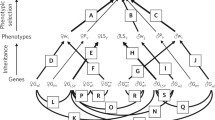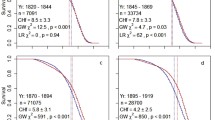Abstract
Menopause is puzzling because life-history theory predicts there should be no selection for outliving one’s reproductive capacity. Adaptive explanations of menopause offered thus far turn on women’s long-term investment in offspring and grandoffspring, all variations on the grandmother hypothesis. Here, I offer a very different explanation. The patriarch hypothesis proposes that once males became capable of maintaining high status and reproductive access beyond their peak physical condition, selection favored the extension of maximum life span in males. Because the relevant genes were not on the Y chromosome, life span increased in females as well. However, the female reproductive span was constrained by the depletion of viable oocytes, which resulted in menopause.
Similar content being viewed by others
References
Alexander, R. D. 1990 How Did Humans Evolve? Reflections on the Uniquely Unique Species. Special Publication 1. Ann Arbor: Museum of Zoology, University of Michigan.
Austad, S. N. 1994 Menopause: An Evolutionary Perspective. Experimental Gerontology 29:255–263.
1997 Why We Age: What Science Is Discovering about the Body’s Journey through Life. New York: J. Wiley and Sons.
Blurton Jones, N. G., and F. Marlowe n.d. The Forager Olympics: Implications for Human Life History, in preparation. Copy in the author’s possession.
Blurton Jones, N. G., L. C. Smith, J. F. O’Connell, K. Hawkes, and C. L. Kamuzora 1992 Demography of the Hadza, an Increasing and High Density Population of Savanna Foragers. American Journal of Physical Anthropology 89:159–181.
Ellison, P. T. n.d. On Fertile Ground: Ecology, Evolution and Human Reproduction. Cambridge: Harvard University Press, in press.
Gaulin, S. J. C. 1980 Sexual Dimorphism in the Human Post-reproductive Life-span: Possible Causes. Journal of Human Evolution 9:227–232.
Goodall, J. 1986 The Chimpanzees of Gombe: Patterns of Behavior. Cambridge, Massachusetts: Belknap.
Gosden, R. G. 1985 Biology of Menopause. The Causes and Consequences of Ovarian Aging. London: Academic Press.
Gurven, M., and K. Hill 1997 Comments on "Hadza Women’s Time Allocation, Offspring Provisioning, and the Evolution of Long Postmenopausal Life Spans." Current Anthropology 38:566–567.
Hamilton, J. B. 1948 The Role of Testicular Secretions as Indicated by the Effects of Castration in Man and by Studies of Pathological Conditions and the Short Life Span Associated with Maleness. Recent Progress in Hormone Research 3:257–322.
Hamilton, J. B., and G. E. Mestler 1969 Mortality and Survival: Comparison of Eunuchs with Intact Men and Women in a Mentally Retarded Population. Journal of Gerontology 24:395–411.
Hamilton, W. D. 1966 The Moulding of Senescence by Natural Selection. Journal of Theoretical Biology 12:12–45.
Hart, C., and A. Piling 1979 The Tiwi of North Australia. New York: Holt, Rinehart and Winston.
Hawkes, K., J. F. O’Connell, and N. G. Blurton Jones 1997 Hadza Women’s Time Allocation, Offspring Provisioning, and the Evolution of Long Postmenopausal Life Spans. Current Anthropology 18:551–577.
Hawkes, K., N. G. Blurton Jones, H. Alvarez, and E. L. Charnov 1998 Grandmothering, Menopause, and the Evolution of Human Life Histories. Proceedings of the National Academy of Sciences, USA 95:1336–1339.
Hill, K., and A. M. Hurtado 1991 The Evolution of Reproductive Senescence and Menopause in Human Females: An Evaluation of the Grandmother Hypothesis. Human Nature 2:313–350.
1996 Ache Life History: The Ecology and Demography of a Foraging People. New York: Aldine de Gruyter.
Howell, N. 1979 Demography of the Dobe !Kung. New York: Academic Press.
Keen, I. 1982 How Some Murngin Men Marry Ten Wives: The Marital Implications of Matrilineal Cross-cousin Structures. Man 17:620–642.
Lancaster, J. B., and B. J. King 1992 Evolutionary Perspective on Menopause. In In Her Prime, second ed., V. Kerns and J. K. Brown, eds. Pp. 7–15. South Hadley, Massachusetts: Bergin and Garvey.
Lovejoy, O. W., R. S. Meindle, T. R. Pryzbeck, T. S. Barton, K. G. Heiple, and D. Kotting 1977 Paleodemography of the Libben Site, Ottawa County, Ohio. Science 198:291–293.
Marlowe, F. 1999a Male Care and Mating Effort among Hadza Foragers. Behavioral Ecology and Sociobiology 46:57–64.
1999b. Showoffs or Providers?: The Parenting Effort of Hadza Men. Evolution and Human Behavior, 20:391–404.
1999c Sharing among Hadza Hunter-Gatherers. Paper prepared for the Symposium on the Evolution of Cooperation. Max Planck Institute, Leipzig, Germany.
Marsh, H., and T. Kasuya 1986 Evidence for Reproductive Senescence in Female Cetaceans. Report of the International Whaling Commission, Special Issue 8:57–74.
Peccei, J. S. 1995 The Origin and Evolution of Menopause: The Altriciality-Life Span Hypothesis. Ethology and Sociobiology 16:425–449.
Rogers, A. R. 1993 Why Menopause? Evolutionary Ecology 7:406–420.
Spencer, B., and F. J. Gillen 1927 The Aruntu: A Study of Stone Age People. New York: Macmillan.
Symons, D. 1979 The Evolution of Human Sexuality. Oxford: Oxford University Press.
Trinkaus, E. 1995 Neanderthal Mortality Patterns. Journal of Archeological Science 22(1):121–143.
Turner, T. R., and M. L. Weiss 1994 The Genetics of Longevity in Humans. In Biological Anthropology and Aging, D. E. Crews and R. M. Garruto, eds. Pp. 76–100. New York: Oxford University Press.
Vallois, H. V. 1961 The Social Life of Early Man: The Evidence of Skeletons. In Social Life of Early Man, S. L. Washburn, ed. Pp. 214–235. Chicago: Aldine.
vom Saal, F. S., C. E. Finch, and J. F. Nelson 1988 Reproductive Senescence: Phenomenon and Mechanisms in Mammals and Selected Vertebrates. In The Physiology of Reproduction, second ed., E. Knobil and J. Neill, eds. Pp. 1213–1314. New York: Raven.
Walker, A., and R. Leakey 1993 The Nariokotome Homo erectus Skeleton. Cambridge: Harvard University Press.
Washburn, S. L. 1981 Longevity in Primates. In Aging, Biology and Behavior, J. March and J. McGaugh, eds. Pp. 11–29. New York: Academic Press.
Weiss, K. M. 1981 Evolutionary Perspectives on Human Aging. In Other Ways of Growing Old, P. T. Amoss and S. Harrell, eds. Pp. 25–28. Stanford: Stanford University Press.
Williams, G. C. 1957 Pleiotropy, Natural Selection, and the Evolution of Senescence. Evolution 11:398–411.
Wood, J. W., S. C. Weeks, G. R. Bentley, and K. M. Weiss 1994 Human Population Biology and the Evolution of Aging. In Biological Anthropology and Aging: Perspectives on Human Variation over the Life Span, D. E. Crews and R. M. Garruto, eds. Pp. 19–75. Oxford: Oxford University Press.
Author information
Authors and Affiliations
Corresponding author
Additional information
Frank Marlowe, Ph.D., is Assistant Professor of Anthropology at Harvard University. He conducts research with the Hadza and his interests include the behavioral ecology of mating systems, life-history theory, and cooperation.
Rights and permissions
About this article
Cite this article
Marlowe, F. The patriarch hypothesis. Hum Nat 11, 27–42 (2000). https://doi.org/10.1007/s12110-000-1001-7
Received:
Accepted:
Issue Date:
DOI: https://doi.org/10.1007/s12110-000-1001-7




